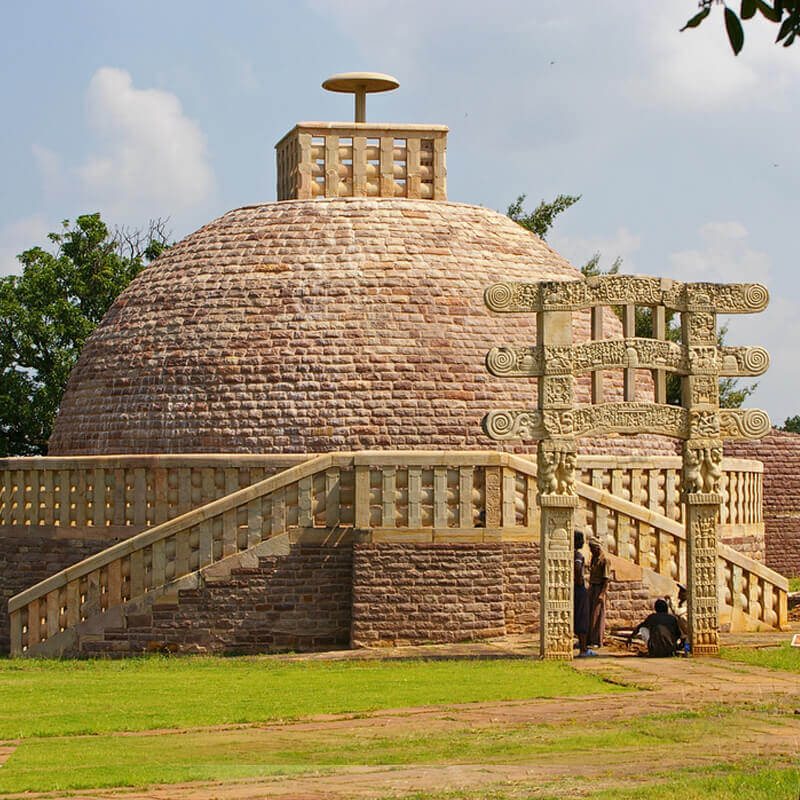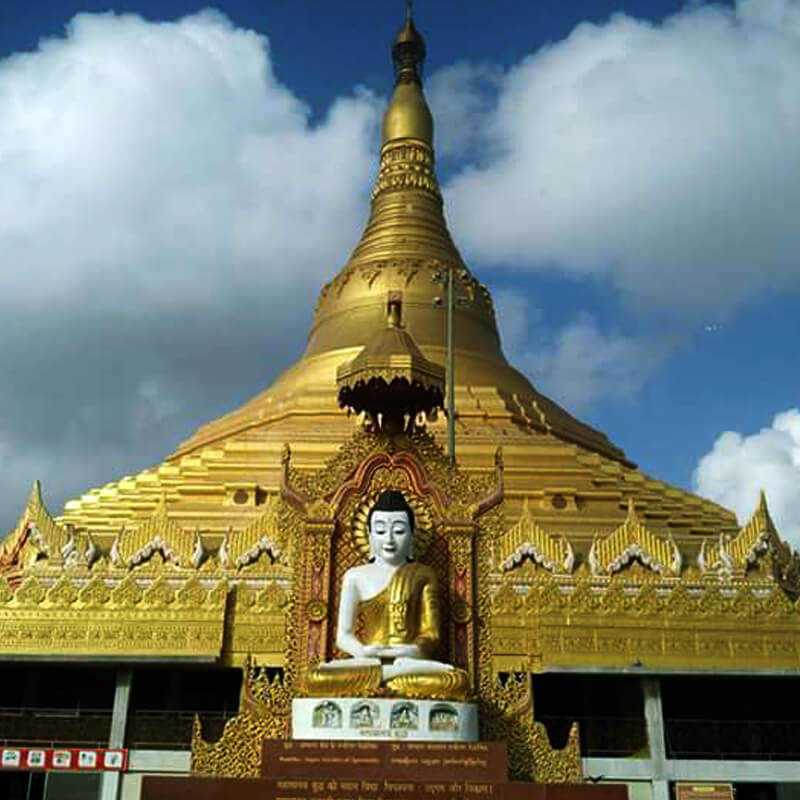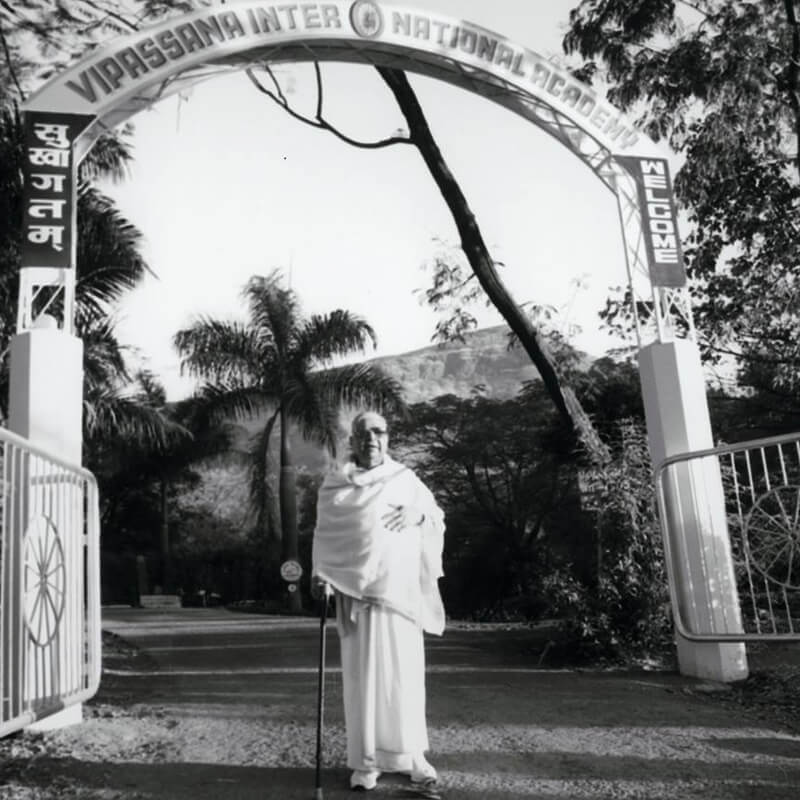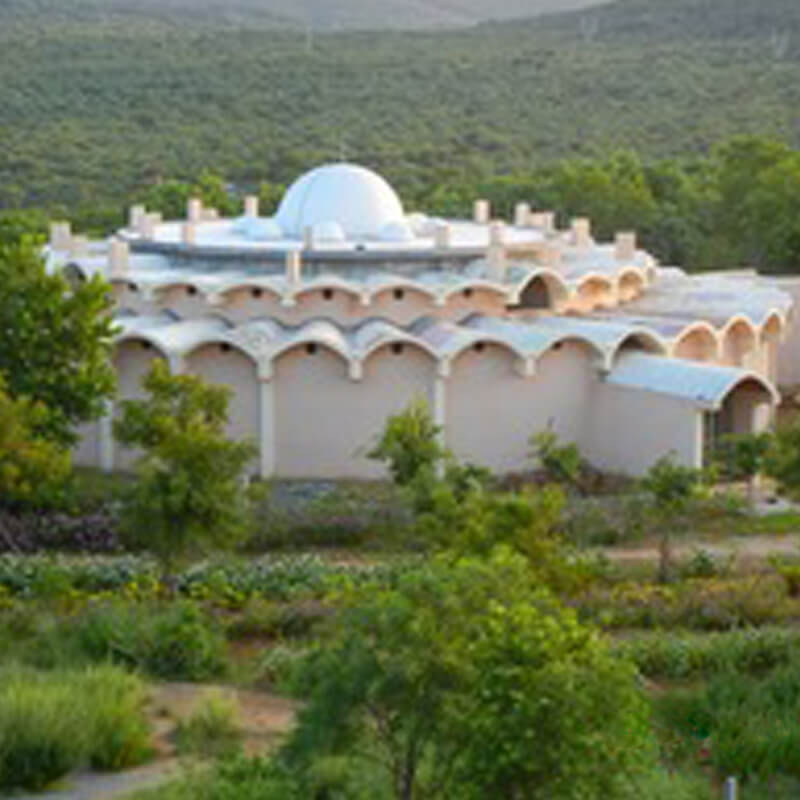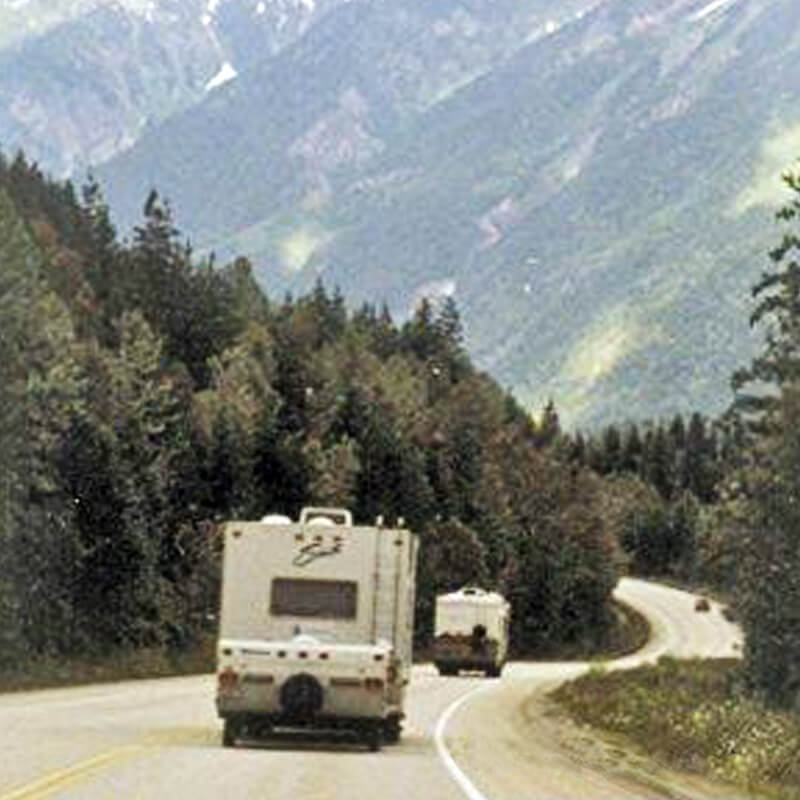From 16 November to 1 December 2004, Goenkaji and Mataji meditated along with 540 students from around the world, at their annual Teachers’ self-course at Dhamma Giri. One week later, on 8 December, they travelled to the Golden Land of Myanmar. Some 400 Vipassana meditators had the good fortune to join the Teachers on the yatra (pilgrimage) to this sacred land, which preserved the priceless Dhamma after it was lost in India, the country of its origin. The pilgrims were from 33 countries and diverse religious backgrounds: Hindu, Muslim, Buddhist, Jewish, Christian, Parsi and Jain.
As the plane descended to land at Yangon (Rangoon), Goenkaji could be heard chanting:
“Jisa dharatī ne janama diyā,
usa dharatī ko hama namana karen;
jisa dharatī ne dharama diyā,
usa dharatī ko hama naman karen…
To the land that gave me birth,
To that land I pay respect;
To the land that gave me Dhamma,
To that land I pay respect…
”
On 10 December, Goenkaji addressed the World Buddhist Summit at the Mahā Pāsāna Cave at Kaba Aye. Goenkaji’s address emphasized the universal appeal of the Buddha’s teaching and how it transcends religious divisions.
The Mahā Pāsāna Cave (lit., ‘great rock cave’) is the historic place where learned bhikkhus (monks) from all over the world gathered for the Chaṭṭha Saṅgāyana (Sixth Synod, or Council), which was held in Yangon from 1954 to 1956. The entire Tipiṭakawas collectively recited and edited to preserve it in its pure form, and was subsequently printed in book form in Myanmar script. This formed the basis for the Chaṭṭha Saṅgāyana CD produced by the Vipassana Research Institute.
One of many highlights for the pilgrims were group meditation sittings at the Shwe Dagon Pagoda led by Goenkaji and Mataji every evening for the first four days.
Shwe Dagon is a sacred site that links Myanmar directly to the Buddha. The first meal that the Buddha took after his enlightenment was the honey-rice of Myanmar offered to him by two traders from Myanmar named Tapussa and Bhallika. The Enlightened One in turn gave eight strands of his hair to the travellers, which they took back to their country and enshrined in the Shwe Dagon.
Shwe Dagon has another significance for Vipassana meditators. When Goenkaji undertook to build a monumental pagoda in Mumbai, the commercial capital and most populated city of India, he decided to make a replica of the revered Shwe Dagon.
The Global Vipassana Pagoda, currently under construction in Mumbai, is one of the most ambitious construction projects ever undertaken. When completed, this awe-inspiring structure will be the world’s largest freestanding stone dome, reaching 325 feet into the air. To give an idea of its magnitude: two of the St Peter’s Basilicas in Rome would be able to fit into its hollow interior. Unsupported by any pillar, it is an engineering marvel, being composed of tens of thousands of huge, individually sculpted stones, transported by thousands of truckloads from quarries located miles away.
The Global Pagoda is not merely a monument celebrating the memory of past greatness. Its arresting exterior beauty and magnitude will definitely attract attention. But the vast interior clear-space will be significantly functional: it will be a meditation hall seating thousands of meditators. The waves of purity of mind and compassion towards all beings generated by the meditations of the practitioners gathered in this unique structure will certainly be a boon. Additionally, the display gallery located on the outside of the pagoda will provide an invaluable service. It will offer to the general public authentic educational and inspirational material to illumine the truth about the Buddha and his teaching, the Dhamma.
In Yangon, the pilgrims visited the International Meditation Centre, the meditation centre established by Sayagyi U Ba Khin, where Goenkaji first learned Vipassana. Goenkaji has referred to IMC as his second birthland, where the shell of ignorance was broken through the liberating practice of Dhamma. The pilgrims undertook another meaningful journey to meditate and pay respects at the meditation centre of Sayagyi’s teacher, Saya Thetgyi. They crossed the Yangon river and travelled to the small village of Pyawbwegyi. The pilgrims were able to meditate in the room where the young U Ba Khin first learned Vipassana meditation in January, 1937.
The meditators were able to give alms and other offerings to the Bhikkhu Sangha (the order of monks) of Myanmar at Dhamma Joti, the Yangon Vipassana meditation centre, as well as at Goenkaji’s residence.
The pilgrims then undertook a 16-hour journey from Yangon to Mandalay in a special train provided by the government. The next day, they went to Kyaukse to visit the monastery of Webu Sayadaw. The Ven. Webu Sayadaw is an important figure in the Vipassana lineage. He was the eminent and saintly monk who exhorted Sayagyi U Ba Khin, in what appears to be a chance meeting, to start teaching meditation. For the rest of U Ba Khin’s life, their spiritual bond was very close. It was at the same Kyaukse station that Sayagyi U Ba Khin taught meditation for the first time to the assistant railway station-master.
The next stop was Bagan, one of Southeast Asia’s most extensive, graceful and impressive archeological sites. Here the pilgrims beheld the devotion to the Enlightened One imprinted upon the landscape in the form of thousands of magnificent pagodas. The meditators visited several prominent pagodas and meditated at different locations. They meditated together at the monastery of Shin Arahan (Arahant Dhammadassi) who was instrumental in purifying the Sangha and spreading the teaching of Vipassana. Shin Arahan is an important link in the chain of teachers, starting from Buddha himself, because of whom the Vipassana meditators have received the peerless Dhamma in the modern age.
Goenkaji was unable to travel to Bagan and Kyautse with the pilgrims. However, he was in Mandalay to lead the group meditation at the historic Mahamuni temple. This temple is very meaningful to Goenkaji. He used to visit it regularly as a child of seven years with his beloved grandfather, Baba. The next day, the meditators visited Dhamma Maṇḍala, the Mandalay Vipassana centre. The pilgrims were happy to see this beautiful centre and received the warm hospitality of a large and warm gathering of Dhamma brothers and sisters. Although construction of the centre has been completed only recently, it is fully equipped with comfortable residential facilities, a spacious Dhamma hall, well-tended gardens, and a pagoda-cell complex, set against the striking backdrop of a steep mountain. The pilgrims again had the opportunity to offer alms to the noble Bhikkhu Sangha of Myanmar. Goenkaji thanked the noble Sangha of Myanmar for preserving the theory and practice of Dhamma through the millennia. He also thanked the people of Myanmar who have been looking after the Sangha so that the Sangha could preserve Dhamma in its purity.
Later, the pilgrims visited the Kutho Daw Gyi where the entire Tipiṭaka has been enshrined on 729 marble slabs by King Mindon Min. King Mindon was a generous supporter of the Bhikkhu Sangha and organized the historic fifth Saṅgāyana (Council) in 1871.
The Yatra then proceeded to Monywa. The pilgrims visited the Monywa Sudaungpyi Pagoda. Many Vipassana courses have been conducted in a building of this pagoda-complex and there are daily group sittings here. The local meditators had arranged lunch for the pilgrims here. The Monywa Vipassana trust has acquired land for a new Vipassana centre. Goenkaji has named it “Dhamma Ñāṇadhaja” (Banner of Knowledge of Dhamma) in honour of Venerable Bhikkhu Ñāṇadhaja, more widely known as Ledi Sayadaw.
After lunch, the pilgrims visited the cave where Ledi Sayadaw regularly meditated. To meditate even for a few moments in the meditation cell of this saintly scholar-monk and Dhamma great-grandfather of Goenkaji, was for many pilgrims a high point of their Dhamma journey to Myanmar. The Ven. Ledi Sayadaw was one of the brightest stars in the galaxy of Vipassana teachers of the modern age. It was due to him that the doors to Dhamma were opened for householders. He not only taught Vipassana to lay people but also appointed Saya Thetgyi, a householder, to teach Vipassana.
Sayagyi U Ba Khin learned Vipassana from Saya Thetgyi, the disciple of the Ven. Ledi Sayadaw. Sayagyi had a Dhamma volition: to return Vipassana to India, its country of origin. Sayagyi’s disciple S. N. Goenka made it the mission of his life to make Sayagyi’s vision a reality. There were about 200 Indian meditators on the pilgrimage to Myanmar, testament to the fact that Vipassana has taken firm roots in India. In many Indian languages, Myanmar is called “Brahmadesh” meaning the land ofbrahmas, the highest plane of existence. Vipassana meditators have developed an even higher esteem for this Golden Land where the jewel of Dhamma was preserved by the noble Bhikkhu Sangha.
After a very inspiring pilgrimage, most of the meditators left Myanmar on the 20th of December.
Goenkaji stayed on in Myanmar. He met many venerable bhikkhus, scholars, old acquaintances and meditators. He also met the local assistant teachers, teachers and trustees to discuss Vipassana activities in Myanmar. He visited Dhamma Joti for group meditation and gave guidance on future development of the centre.
Goenkaji used most of his time in Myanmar to work on the writing of the first two maṅgalas (welfares) in the Mangala Sutta. The booklet “Sangat Sajjana kī Bhali” [Beneficial is the company of saintly people] is almost ready for printing and should be available to meditators by March 2005.
Myanmar has the largest Bhikkhu Sangha (order of monks). The exemplary bhikkhus in Myanmar are very heedful about following the Vinaya (rules of conduct) laid down by the Buddha. A bhikkhu is ordained only after the age of twenty years. Up until that age one remains a sāmaṇera (novice). There are thousands of sāmaṇeras (novices) from the age of seven onwards who live and study in the monasteries of Myanmar. According to the rule laid down by the Buddha, one can become a sāmaṇeraor a bhikkhu only after getting permission from one’s parents.
Recently quite a few young sāmaṇeras have taken children’s Anapana courses. Goenkaji gave a special Anapana session for the sāmaṇeras at Dhamma Joti on 30 December in which 269 sāmaṇeras participated. It was a great joy to see these young novices from 7 to 16 years of age meditating in the meditation hall at Dhamma Joti.
Goenkaji told the young practitioners about the prince Siddhattha who had practiced Anapana at the age of seven. The ascetic prince Siddhattha discovered that all the other samādhis as well as the most severe austerities did not eradicate all suffering.
The young prince then remembered that as a child he had once practised awareness of respiration under a tree while his attendants had gone to take part in local festivities. This experience had brought him much peace and joy. Now after leaving aside the two extremes (of self-mortification and excessive indulgence in sensual pleasures), he embarked on the journey to liberation by starting with the awareness of natural respiration. Anapana led Siddhattha to Vipassana and thenceforth to liberation. Thus, Anapana has a very special place in sammā-sāmādhi (right concentration of mind) taught by the Buddha.
Goenkaji also related the story of Rahula, the Buddha’s son, who was also ordained as a novice at the age of seven; and about various other young boys such as Revata, Sivali, and Pandita who ordained at the age of seven or eight and became arahats.
The novices were very inspired by Goenkaji’s talk. Many of them wrote letters after the course saying that they wanted to grow up to be virtuous monks established in meditation and to serve humanity by spreading Dhamma.
Earlier in his stay, Goenkaji could not accept invitations to give public talks due to his health. Happily, his health later improved a little, so he accepted an invitation to give a talk at the University of Yangon on 19 January. The hall filled up and people sat in the corridors and stood outside to listen to the first talk. The organizers therefore urged Goenkaji to give two more talks on 20 and 21 January. The audience consisted of university students and academicians in addition to Vipassana meditators. Goenkaji explained what is taught in the Vipassana courses and explained why the Buddha gave importance to respiration as an object ofsāmādhi (concentration) and how vedanā (sensation) is so important in the field of paññā (wisdom).
Another series of three public talks was organized at the Abhidhamma Society, Yangon on 26, 27 and 28 January. In his first lecture, Goenkaji talked about sīla (morality). According to the Buddha, morality is important not merely as a social code or to avoid censure from society or to avoid punishment from the government. Neither is it merely a behavior that one expects from others in the society, causing one to follow it as an obligation. One who walks on the path of Dhamma understands that the reason why it is important to practise morality is that every time one indulges in any immoral vocal or physical action, one generates some defilement or the other in the mind and thus makes oneself miserable. One understands this from one’s own experience. A meditator understands that unwholesome (immoral) actions originate from a defiled mind.
“Manopubbaṅgamā dhammā,
manasā ce paduṭṭhena,
bhāsati vā karoti vā;
tato naṃ dukkhamanveti,
cakkaṃva vahato padaṃ.
Mind precedes all phenomena;
mind is their chief; all phenomena are mind-made.
If, with an impure mind,
one should speak or act,
suffering follows one
as the cart-wheel follows the foot of the ox.
”
Goenkaji further explained that an unwholesome action produces misery not just once. The Buddha said that misery follows one just as the cart-wheel follows the ox yoked to the cart. This is because, through ignorance, one continually reinforces the habit of committing unwholesome actions.
One understands that wholesome (moral) actions originate from a pure mind.
“
Manopubbaṅgamā dhammā,
manoseṭṭhā manomayā;
manasā ce pasannena,
bhāsati vā karoti vā;
tato naṃ sukhamanveti,
chāyāva anapāyinī.
Mind precedes all phenomena;
mind is their chief; all phenomena are mind-made.
If, with a pure mind,
one should either speak or act,
happiness follows one
as one’s shadow that never leaves.
”
This is because one forms a habit of kusala (wholesome) actions and these kusala actions keep one happy and peaceful.
(to be concluded)

